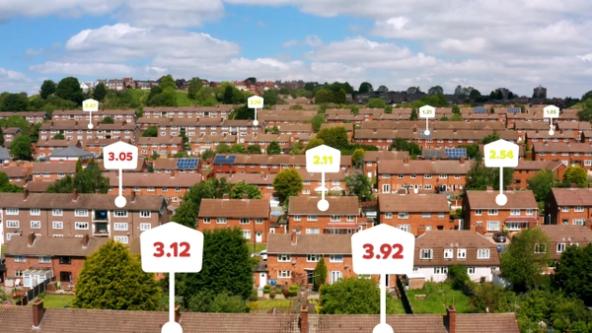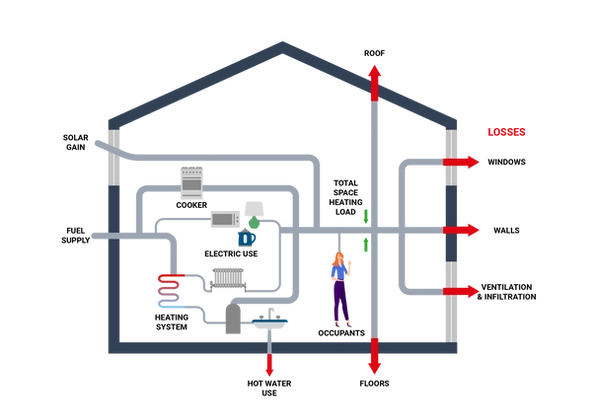Technical
What is a Heat Transfer Coefficient (HTC)?
HTC is the true test of how thermally efficient a property is. Put simply, a Heat Transfer Coefficient (HTC) represents all of the heat lost from a dwelling during the winter, through the walls, roof, floor and windows, and by air movement from outside to inside the home. That makes it the ultimate barometer of how well the home keeps heat in and cold out.

In most buildings, 60% or more of the total energy consumption is attributable to space heating. This makes it the single biggest source of CO2 emissions from the built environment and one of the largest pain points in terms of running costs. Understanding the thermal performance of the building envelope and the energy required to maintain a comfortable internal temperature is therefore vital. It allows property owners to check that the building is thermally efficient whilst also helping to inform investment decision-making in terms of further insulation upgrades or determining the most appropriate replacement heating system.
The HTC is a measure of the rate of heat loss per degree temperature difference between inside and out. It is expressed in units of Watts/Kelvin (or Celsius) so that if a building has an HTC of 100 it would require a constant power input of 100W to keep it 1 degree warmer inside than out. You can then use this value to determine the likely peak heating demand. For instance, for an internal temperature of 21°C whilst the outdoor temperature is 0°C, simply multiply the HTC value by the overall 21°C temperature difference. So in the case of a HTC of 100W/K, the peak heat demand requirement would be 2.1kWp.
As the HTC is not normalised by the size of the building, it is often divided by the total floor area of the building so that the thermal efficiency of buildings of different sizes can be directly compared, this is called the Heat Loss Parameter (HLP).

All models of thermal performance or energy consumption in buildings are based upon a predicted HTC in order to define the heat demand – building energy modelling methods such as SAP, RdSAP, Passivhaus PHPP, BS 12831 and even dynamic energy models such as Energy Plus and IES. The limitation however is that the modelled output is only ever as good as the quality of inputs, with aspects such as thermal bridging, U-values, infiltration and ventilation losses all very difficult to reliably predict. For example, our own research, in partnership with the Energy Saving Trust on behalf of the Department for Energy Security and Net Zero (DESNZ), has found that RdSAP-based EPCs only predict the thermal performance of a building correctly in 44% of cases.
Many other studies have shown that calculated HTCs can vary widely from the actual measured value. Direct measurement of HTCs can therefore help to validate the true performance of the homes that we build whilst also helping to better characterise the existing stock to allow more effective targeting of investment in energy efficiency measures and heating system upgrades.
The relationship between HTC and space heating demand
The space heat demand of a building is another commonly used metric for thermal performance, it describes the amount of heat required to heat a building to maintain the inside of a building to a particular heating profile for a given set of weather conditions. Space heating demand is typically reported in units of kWh/year, i.e. the amount of heat energy required over a year. Of course, internal and external conditions vary between each building, so the space heat demand can either be tailored to a particular building and its occupants or calculated for an assumed set of internal and external conditions via an energy model. If tailored to the building and its occupants, the space heat demand can be instructive, but it will not be comparable with the space heat demand calculated for other buildings. Both approaches have value and should be chosen depending on the intended use.
The HTC and rate of heat transfer, or heat loss when we are considering heating demand, is unsurprisingly closely related to space heat demand. The exact relationship between the two is dependent on how the building is heated (the setpoint and heating periods), the weather and the amount of solar and other internal gains (such as from people, appliance use or hot water heating). Generally, however, the relationship is close to linear with higher space heat demand for a higher HTC (i.e. worse thermal performance).
Space heating demand predictions get a lot of attention but it is often overlooked that the primary driver is the performance of the building fabric (the HTC). The other factors influencing the demand profile are highly variable and will change over time and with different occupancy behaviours. Here at Build Test Solutions, we believe that you should focus mostly on controlling the controllables; get the building fabric right, verify this with measurement and everything else will follow. Rely on performance estimates and only do a mediocre job of the building fabric and you land in a grey area of not quite being sure if the heating and ventilation systems are a good match, whether occupants are using energy as you expected or if the high bills are just a blip because of a cold snap in the weather.
More detail on how HTC and space heat demand are related can be found in The Relationship between Thermal Performance and Space Heat Demand.

How to measure the Heat Transfer Coefficient of buildings
Since predicted HTC is calculated in energy models in order to define the heat demand, it’s often possible to directly compare a measured HTC with the predicted value. The difference between the predicted and measured HTC is commonly called the performance gap.
Up to now, HTC testing has required properties to be fully vacant, which can cause serious disruption for residents, making them unwilling to allow their property to be tested.
Fortunately, technology is advancing.
Build Test Solutions’ SmartHTC is a non-invasive method to measure the thermal performance of buildings. Measurement takes place over a three-week period while a property is occupied and lived in as normal. It analyses the overall thermal performance of buildings using basic building information, energy use (from meter readings or smart meter data), internal temperature and local weather data. This process is carried out during the colder months, October to March in the UK, because in order to get a reliable reading there needs to be a positive internal to external temperature difference.
When combined, the data can then be used to determine a measured HTC of the specific property. From this, the HLP and peak heat demand can also be readily established.

Benefits of measuring the Heat Transfer Coefficient of a house
Obtaining a measured HTC for a building unlocks a wide range of opportunities:
- Determine the performance of a home. Is it in line with expectations, identify if high heat loss is an issue and provide tailored advice.
- Assess the suitability of installing a heat pump or alternative low-carbon heating system. What is the peak heat demand and can this be readily delivered by the proposed equipment?
- Stock assessment and targeting of retrofit works. Social and private landlords can assess each property individually and only invest in solutions that will provide maximum return on investment.
- Quality assurance on retrofit works and new-build homes. Check and verify that contractors have completed works to the agreed level.
- Use a measured HTC to assist in the remediation of complaints regarding heating costs. Landlords or housing associations can use data to assess the severity of thermal performance issues and act accordingly.
- Quantify the effect of energy improvement or fuel poverty alleviating measures. Data builds trust between landlords and residents by showing them factual data about the improvements made to a property through pre and post-measure assessments.
- Validate the benefits of innovative thermal performance products. Test the effectiveness of products, before investments are made across multiple properties.
Measurement is key if the UK’s housing stock is to meet net zero by 2050. Understanding the specific HTC of each property allows homeowners, landlords, contractors and developers to actively plan, act and check as-built thermal performance without any of the usual complexities associated with occupancy factors or weather conditions.



